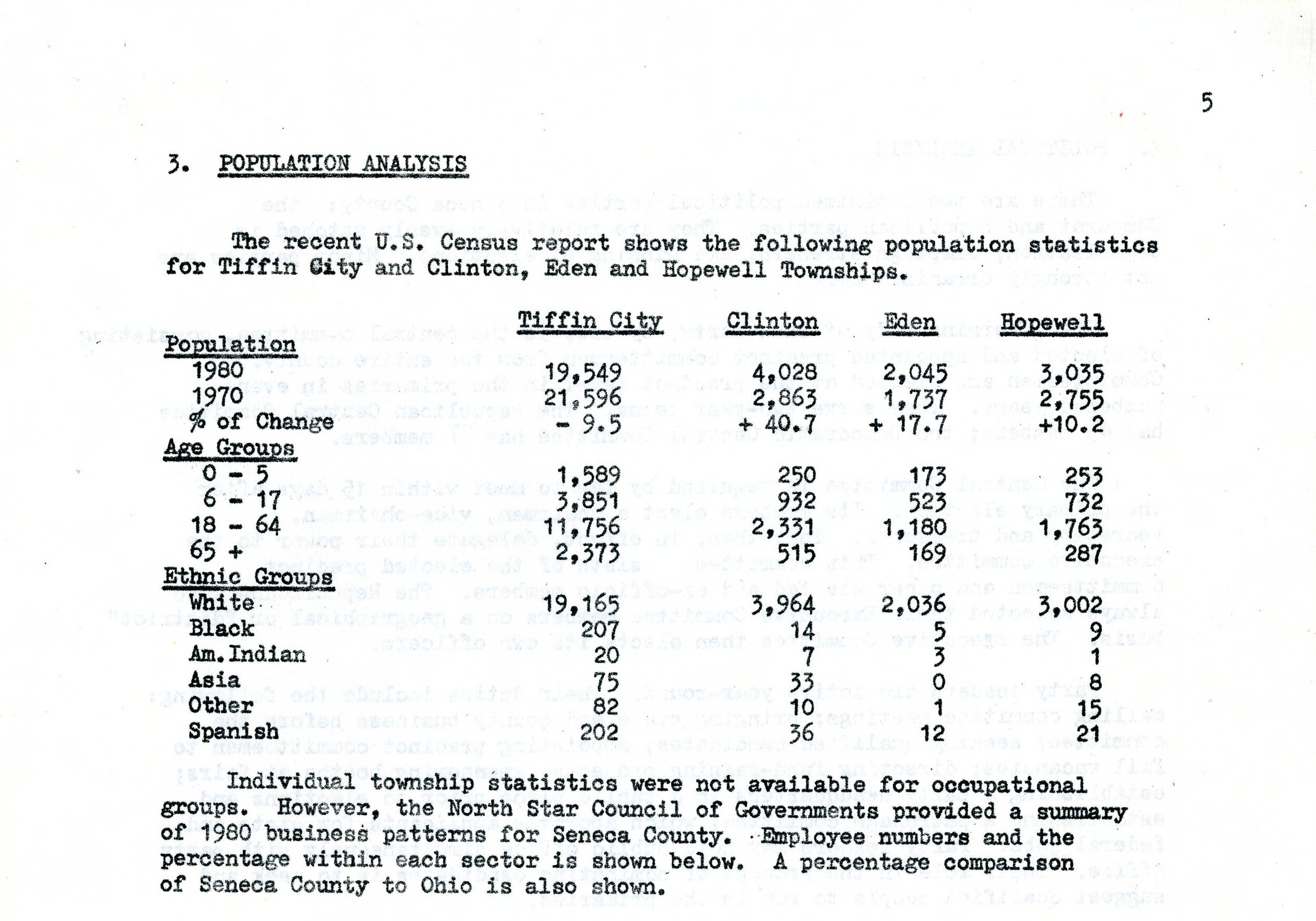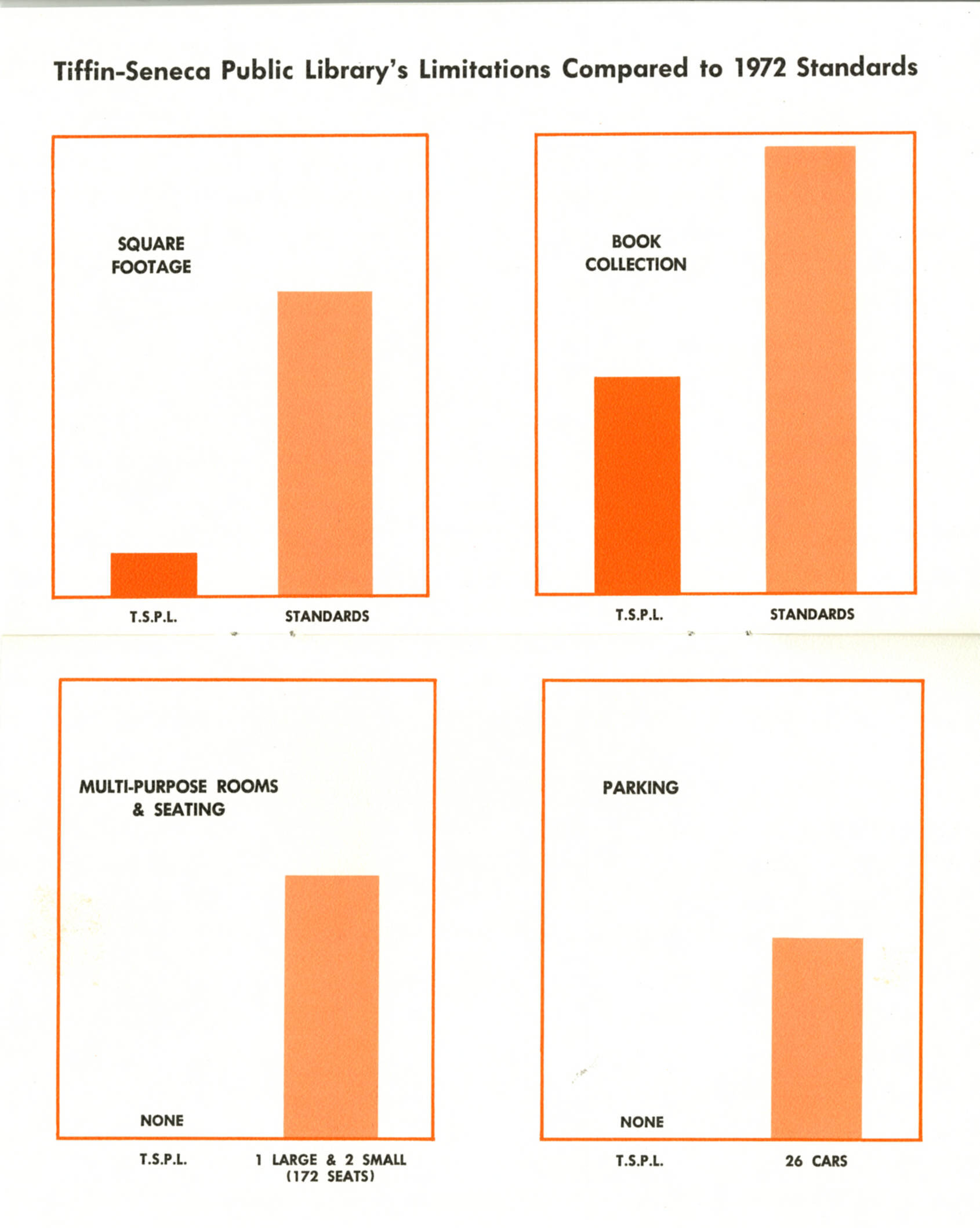By Emily Rinaman, Technical Services Librarian
*World Population Day is celebrated annually on July 11*
Last year around this time the United States Census Bureau was busy finishing its collection of Americans’ forms for the 2020 United States Census. The U.S. census has occurred every 10 years since 1790, and many trends and statistics are gathered, tracked, and reported based on citizens’ answers. The information received by the Census Bureau helps the government decide how to distribute funds.
While there is a margin of error – only 67 percent of citizens nationwide responded to the most recent census –both Ohioans and residents of Tiffin were slightly above average in their reporting. Seventy percent of Ohioans responded and 71.7% of Tiffin residents did. (The lowest response rate throughout the country was 35% and the highest was 75%).
There have been several organizations in Tiffin that have compiled population statistics, including the U.S. censuses, for their own purposes. The First Presbyterian Church relied heavily on population statistics to choose the best site for its new location back in the 1960s. Likewise, the Tiffin-Seneca Public Library used statistics in the 1970s to make a case for its present building (see photos for examples).
The ‘60s was an era of rapid expansion for Tiffin, and Tiffin’s population actually peaked around 1970 before steadily declining ever since. Worldwide this is a common trend in many areas of developed countries. The United Nations Population Fund reports that in the early 1970s women average 4.5 children each but by 2015 this fertility rate has been cut in half to 2.5 children per woman.
Seneca County and the smaller municipalities within it have seen similar trends historically. To mirror the national trend of immigration waves, Seneca County saw a major spike in its population in the 1830s-1840s (from 5,100 in 1830 to 18,100 in 1840) when many Europeans arrived before tapering off in the 1850s. The county grew to 27,100 residents in 1850 but reported around 30,800 in both the 1860 and 1870 censuses). It’s noted in “Tiffin’s 75th Anniversary Souvenir” that “settlers east of the Sandusky River were mostly Americans from Southern Ohio, Maryland, Pennsylvania, New York and Virginia, while those west of the river were largely German, Irish and French immigrants.”
To put it into perspective, the Moore’s Standard Directory Tiffin 1908-1909 notes that there were 30 “whites” living in Tiffin in 1822 and that number had risen to 600 just ten years later. Bascom and Republic both contained about that same number of residents (550 for Bascom and 425 for Republic) at that time. Bascom’s population doubled to 1300 residents by 1850 but Republic only grew to 800. Bloomville was another close contender with almost 400 residents in 1830. It grew to 1160 residents by 1840. Bettsville and Green Springs were slower to grow, as both villages still only had about 25-30 residents each in 1840. Fostoria, likewise, only had 80 residents in 1840 but less than 10 years later grew to 300 residents. Even Omar was bigger than Fostoria at one time. In 1830 there were 265 residents and built its first public school in 1837. By 1840 its population had increased by 1,000 people. Just 10 years after its first school began, it had 11 full and 4 “fractional” school districts (or sub-districts) educating 676 pupils.
Seneca County’s townships’ numbers have also been recorded separately at times. “Lands in Lodi” reported that there were 1200 residents in Reed Township by 1840 and 80 people within 14 dwellings in West Lodi. Eden Township already had 800 residents in 1830 but grew slowly but surely until reaching the 2,000 mark at the 2000 United States Census. Big Spring Township, where New Riegel and Adrian are located, is a little more sparse with New Riegel boasting 200 residents in 1870 and 350 in 1880.
Smaller waves of immigrants both nationally and locally aided the growth of Tiffin and Seneca County in the later half of the 19th century.
Oil and railroads were two technologies which brought people to the area. In 1895, Sun Oil Company struck 2 oil wells near Risingsun and Wood County went on to dig 1700 wells. The Mad River and Lake Erie Railroad became a direct link to Northwest Ohio and its promising farmland. During the middle of the 19th century “the land between Lake Erie and the Ohio River started to develop.”
In fact, while Tiffin and Seneca County are considered quite rural in today’s terms, it was actually more “bustling” than Toledo at one point. Charts created by the Ohio Development Services Agency illustrates that in 1850 Seneca County actually had twice as many people as Lucas County and beat out all of the surrounding counties in terms of population except for Huron County. It wasn’t until 1900 when Wood, Lucas and Hancock Counties surpassed Seneca County in numbers. Sandusky County didn’t become larger than Seneca County until after well into the 20th century.
At this time the ratio of urban to rural dwellers was 60/40 but by 2020 it had switched to a 80/20 ratio. By the year 2050 the United Nations Department of Economics and Social Affairs assumes the ratio will become 90/10. Charts on its website help visualize that this isn’t a reflection of people moving from rural areas to cities – the number of rural dwellers has remained steady. Rather, the discrepancy is from the number of urban dwellers drastically increasing. This is reflected by the U.S. Census – since the very first census, New York City has remained the most populated city in the United States.
Whatever the case, for now, a large majority of Tiffinites and Seneca County residents remain loyal to their little spot in the world where their ancestors settled. One out of every two people in the county choose to live and work within 15 minutes of home, according to Data USA. Perhaps the more things change the more they stay the same?
Works cited:
Bascom Area Sesquicentennial 1837-1987. https://www.ohiomemory.org/digital/collection/p15005coll27/id/41849/rec/1
Bloomville, Ohio. https://www.ohiomemory.org/digital/collection/p15005coll27/id/29238/rec/2
Green Springs Ohio Centennial. https://www.ohiomemory.org/digital/collection/p15005coll27/id/29439/rec/1
Data USA. https://datausa.io/profile/geo/tiffin-oh
Fostoria Centennial Souvenir Program and History, 1954. https://www.ohiomemory.org/digital/collection/p15005coll27/id/31551/rec/1
History of Republic, Ohio.
History of Bettsville, Ohio. https://www.ohiomemory.org/digital/collection/p15005coll27/id/29509/rec/1
History of New Riegel. https://www.ohiomemory.org/digital/collection/p15005coll27/id/33590/rec/1
Lands in Lodi. https://www.ohiomemory.org/digital/collection/p15005coll27/id/44538/rec/2
Mad River and Lake Erie Railroad: Its history and Significance to the Sandusky Valley. https://www.ohiomemory.org/digital/collection/p15005coll27/id/22213/rec/1
Memories 1906-2006: Melmore Alumni Banquet June 3, 2006. https://www.ohiomemory.org/digital/collection/p15005coll27/id/29761/rec/1
Ohio Development Services Agency. https://development.ohio.gov/files/research/g113_OhioPopulationHistory.pdf
Omar A Community of Memories. https://www.ohiomemory.org/digital/collection/p15005coll27/id/41398/rec/1
Risingsun, Ohio. https://www.ohiomemory.org/digital/collection/p15005coll27/id/30016/rec/6
Seneca County Digital Library. https://www.ohiomemory.org/digital/collection/p15005coll27
Tiffin’s 75th Anniversary Souvenir. https://www.ohiomemory.org/digital/collection/p15005coll27/id/22962/rec/1
United Nations Department of Economics and Social Affairs. https://population.un.org/wup/Country-Profiles/
United States Census Bureau. https://2020census.gov/en/



